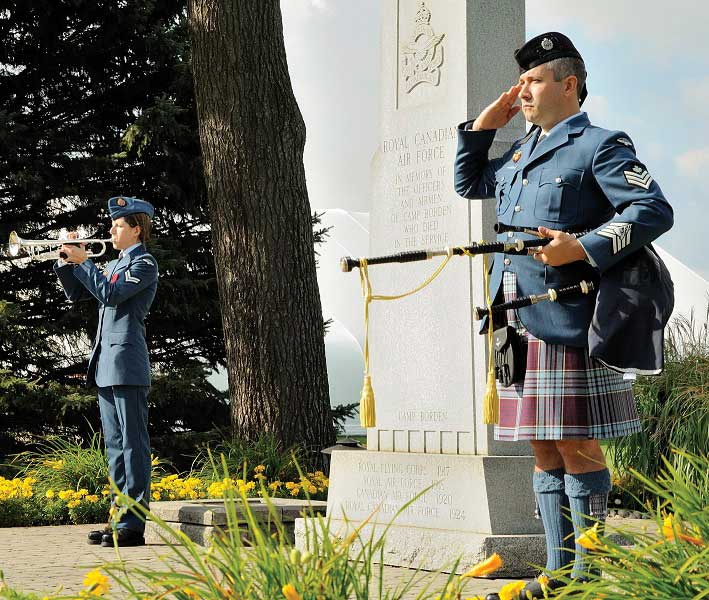
By / Par Leighsah Millward and / et MWO / Adjum Douglas Hennessey, CFB / BFC Borden
After the Nazi forces took France and a large portion of continental Europe in 1940, their attention turned to England. Hitler, expecting Britain to sue for peace, was disappointed by the nation’s lack of response and was forced to launch Operation Sea Lion on July 16, 1940. The Operation began the quest for control of the English Channel, specifically the air space above it, which was critical for moving ships and troops into position. This is the first time in history that conflict between nations had ever been taken to the air.
“The purpose of this operation will be to eliminate the English homeland as a base for continuation of the war against Germany and, if necessary, to occupy it completely,” stated Hitler. Decimation of the British military forces was necessary to prevent any opposition to the plan.
Thus during the month of July, 1940, the Luftwaffe began attacking Channel convoys and ports, as well as radar stations on England’s southern coast. By August, the main assault was underway, targeting British airfields, and aircraft factories alongside the original targets.
The opposition to this constant barrage was the 2,353 piliots and aircrew of the Royal Air Force (RAF), and 574 personnel from overseas including more than 100 Canadians who fought in some of the hardest hit areas. It was during the Battle of Britain that No. 1 Royal Canadian Air Force (RCAF) Squadron became operational, later designated 401 Squadron. Three members of this squadron received the Distinguished Flying Cross for their actions during this battle. Canadians also fought in the RAF’s 242 (Canadian) Squadron alongside the British and in other RAF Squadrons, as well as Bomber and Coastal Commands providing operational support.
It was during these momentous days that Churchill famously stated “Never in the field of human conflict was so much owed by so many to so few.”
The airmen were exhausted deflecting the attacks. The factories were pushed to their limits supplying aircraft, and the British Commonwealth Air Training Plan steadily turned out newly trained pilots and crew. Steadfastly, the British people endured.
A mistake by a Luftwaffe aircraft turned the battle. At the end of August 1940, the aircraft dropped a bomb on the City of London, sparking retaliation with the bombing of the City of Berlin. This infuriated Hitler and brought The Blitz – 57 nights of German bombing on London, moving the German forces away from previous targets and closer to additional British reinforcements. The British airfields and radar stations were hurriedly repaired, giving the British forces a chance and turning the battle. By the end of October, denied his objective, Hitler turned his attention to Russia and postponed Operation Sea Lion, causing the attacks to peter out.
The Battle of Britain was the first time in Canadian history that Canada’s own identifiable air assets participated in fighting missions. Twenty-three Canadians lost their lives during the battle. A parade was held at CFB Borden on September 18 at the RCAF Memorial on Maple Leaf Drive; honoring their sacrifice and recognizing the courage and sacrifice that enabled the Allied Forces to achieve a historic victory.
Col Andrew Fleming, Commander of 16 Wing and event Reviewing Officer, paid tribute to those who fought in the Battle of Britain by recalling the efforts of the British, Commonwealth and Allied aircrew. One in three of these young men, whose average age was 22, was either killed or wounded. However, Col Fleming reminded those in attendance that these brave aircrew were not alone in their fight. They prevailed over the enemy, despite all odds, because the Luftwaffe failed to recognize that it was facing an integrated defence system. This included civilian scientists who developed and fielded radar, civilian workers who produced fighter aircraft at the rate of 100 per week, countless air technicians, observers, plotters and commanders who also lost their lives during the enemy’s daily attacks on airfields and headquarters. Through the Canadian-led British Commonwealth Air Training Plan, Camp and RCAF Station Borden contributed heavily as the home of No 1 Service Flying Training School.
In paying tribute to those that lost their lives in this endeavor, on this 76th Anniversary of the Battle of Britain, Col Fleming also asked of those in attendance that they reflect on the indomitable spirit they displayed when faced with daunting adversity. Lest we forget.
Sources: RCAF
Rappelons-nous notre rôle dans la bataille d’Angleterre
Après que les forces nazies eurent occupé la France et une grande partie de l’Europe continentale en 1940, Hitler a concentré son attention vers l’Angleterre. Celui-ci, qui s’attendait à voir les Britanniques solliciter la paix, a été déçu par leur silence et a été obligé de déclencher l’opération Sea Lion, le 16 juillet 1940. Celle-ci avait pour objet l’acquisition de la maîtrise de la Manche et, plus particulièrement, de l’espace aérien au dessus d’elle, ce qui était essentiel pour que les navires et les troupes puissent se rendre à leur position en temps opportun. C’était la première fois de l’histoire qu’un conflit international prenait une dimension aérienne.
« Cette opération visera à éliminer la capacité de l’Angleterre à servir de base pour la poursuite de la guerre contre l’Allemagne et, au besoin, à l’occuper entièrement », a déclaré Hitler. Il lui fallait donc décimer les forces militaires britanniques pour empêcher toute opposition à son plan.
C’est ainsi qu’au cours de juillet 1940, la Luftwaffe a commencé à attaquer les convois et les ports dans la Manche ainsi que les stations de radar sur la côte sud de l’Angleterre. En août, l’assaut principal a été lancé et ont alors été pris à partie les aérodromes et les usines d’avions britanniques à proximité des cibles originales.
Face à ce barrage constant se sont alignés 2 353 pilotes et aviateurs de la Royal Air Force (RAF) et 574 militaires venus d’outre-mer, y compris plus de 100 Canadiens qui ont combattu dans certains des secteurs les plus durement touchés. Ce fut au cours de la bataille d’Angleterre que la 1re Escadrille de l’Aviation royale canadienne (ARC) est devenue opérationnelle; elle a plus tard pris le nom de 401e Escadrille. Trois membres de cette unité ont mérité la Croix du service distingué dans l’Aviation (DFC) pour leurs exploits accomplis pendant cette bataille. Des Canadiens ont aussi fait partie de la 242e Escadrille (canadienne) de la RAF et ont combattu aux côtés de Britanniques et d’autres escadrilles de la RAF et de concert avec le Bomber Command et le Coastal Command en leur assurant le soutien opérationnel.
Ce fut au cours de ces journées décisives que Churchill a fait sa célèbre déclaration : « Jamais dans l’histoire des conflits humains une dette aura-t-elle été si grande à l’endroit d’un si petit nombre. » Les aviateurs étaient épuisés à force d’enrayer les attaques ennemies. Les usines d’avions ont été poussées jusqu’à leurs limites, et le Plan d’entraînement aérien du Commonwealth britannique a continué sans relâche à former de nouveaux pilotes et hommes d’équipage. Résolument, le peuple britannique a tenu bon.
Un avion de la Luftwaffe a commis une erreur qui a changé la donne. À la fin d’août 1940, cet avion a largué une bombe sur Londres, ce qui a entraîné, par mesure de représailles, le bombardement de Berlin. Furieux, Hitler a ordonné le fameux blitz : pendant 57 nuits d’affilée, les Nazis ont bombardé Londres et dirigé leurs forces loin des cibles antérieures et plus près d’autres renforts britanniques. Les aérodromes et les stations de radar britanniques ont été réparés à la hâte, ce qui a donné une chance aux forces britanniques et changé le cours de la bataille. À la fin d’octobre, n’ayant pu atteindre son objectif, Hitler a alors dirigé son attention vers la Russie et reporté l’opération Sea Lion. Les attaques contre l’Angleterre ont finalement cessé.
C’est pendant la bataille d’Angleterre que notre pays a pour la première fois de son histoire aligné une unité aérienne reconnaissable au combat. Vingt trois Canadiens ont perdu la vie au cours de la bataille. Le 18 septembre dernier, un défilé a eu lieu à la BFC Borden, au Monument commémoratif de l’ARC sur la promenade Maple Leaf, pour rendre hommage à leur sacrifice et évoquer le courage et l’abnégation qui ont permis aux Forces alliées de remporter une victoire historique.
Le Col Andrew Fleming, commandant de la 16e Escadre et officier de la revue, a rendu hommage à ceux qui avaient combattu pendant la bataille d’Angleterre et il a alors rappelé les efforts des équipages aériens britanniques et alliés et ceux du Commonwealth. Le tiers de ces jeunes gens, dont l’âge moyen était de 22 ans, ont été tués ou blessés au cours de cette période. Toutefois, le Col Fleming a aussi attiré l’attention de l’auditoire sur le fait que ces braves aviateurs n’ont pas combattu seuls. Ils l’ont emporté sur l’ennemi, contre toute attente, parce que la Luftwaffe n’a pas su comprendre qu’elle faisait face à un système de défense intégré qui regroupait des scientifiques civils créant et mettant en service des radars, des travailleurs civils qui construisaient des avions à une cadence de 100 par semaine et d’innombrables techniciens d’aéronefs, observateurs, traceurs et commandants qui ont aussi perdu la vie pendant les attaques quotidiennes de l’ennemi contre les aérodromes et les quartiers généraux. Grâce au Plan d’entraînement aérien du Commonwealth britannique, dirigé par le Canada, Camp Borden et la Station de l’ARC du même nom ont grandement contribué à l’effort, car c’était la base de la 1re École de pilotage militaire.
En rendant hommage à ceux qui ont perdu la vie au cours de cette période, à l’occasion du 76e anniversaire de la bataille d’Angleterre, le Col Fleming a aussi demandé à l’assistance de réfléchir à la ténacité à toute épreuve qu’ils ont manifestée face à une adversité extrême. Nous nous souviendrons d’eux.
Source : ARC





